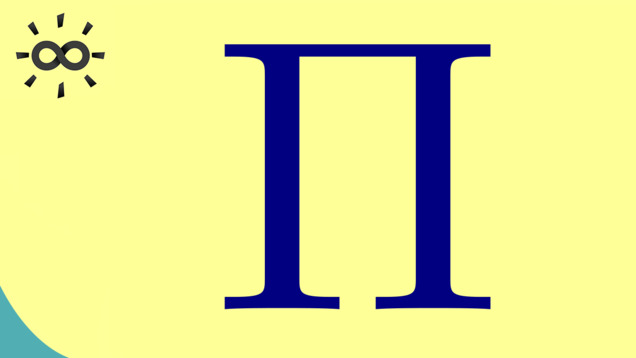
-
Title: Product Symbol
-
Series: Advent of Mathematical Symbols
-
YouTube-Title: Advent of Mathematical Symbols - Part 8 - Product Symbol
-
Bright video: https://youtu.be/5MS5wu49mgM
-
Dark video: https://youtu.be/-ivgh3-BWfU
-
Quiz: Test your knowledge
-
Dark-PDF: Download PDF version of the dark video
-
Print-PDF: Download printable PDF version
-
Thumbnail (bright): Download PNG
-
Thumbnail (dark): Download PNG
-
Subtitle on GitHub: aoms08_sub_eng.srt
-
Timestamps (n/a)
-
Subtitle in English
1 00:00:00,714 –> 00:00:03,714 The mathematical symbol of today is the product symbol.
2 00:00:03,771 –> 00:00:05,672 Written with a capital Pi.
3 00:00:06,186 –> 00:00:12,057 and in the same way as we have it for the sum symbol, we use an index below the letter Pi.
4 00:00:13,229 –> 00:00:20,857 So here k starts with the value 1 goes through all natural numbers until we reach the value n in the end.
5 00:00:21,629 –> 00:00:26,966 Hence this symbol here is a short notation for a product with exactly n factors.
6 00:00:27,857 –> 00:00:34,377 More precisely we start with “a_1” times “a_2” times “a_3” and so on.
7 00:00:34,400 –> 00:00:36,633 Until we reach “a_n”.
8 00:00:37,414 –> 00:00:44,227 Of course “a_1”, “a_2” and so on could be any numbers. The thing important is only that we have an index involved.
9 00:00:45,043 –> 00:00:50,154 On the left hand side we call it k, but of course any other name would do it as well.
10 00:00:50,971 –> 00:00:55,038 Now you can see the whole thing here as an explanation for the product symbol,
11 00:00:55,129 –> 00:00:59,067 but the formal definition should be given by a recursive definition.
12 00:00:59,800 –> 00:01:04,395 This means that we first have to explain what the empty product should be.
13 00:01:04,971 –> 00:01:08,335 In other words what happens when we set n to 0.
14 00:01:09,214 –> 00:01:14,714 Then the explanation from above does not make any sense, because there are no numbers involved.
15 00:01:15,400 –> 00:01:20,509 Indeed the only meaningful thing would be to set the empty product to 1.
16 00:01:21,200 –> 00:01:25,076 Because when we multiply with 1, we don’t change anything.
17 00:01:25,957 –> 00:01:33,699 and now you might already know for recursive definition, we have to say what happens to the successor, when we know the predecessor.
18 00:01:34,400 –> 00:01:40,743 This means that here on the right hand side we have the product that goes through k = 1 to (n - 1)
19 00:01:40,814 –> 00:01:45,529 and we want to reach this product, where k goes from 1 to n.
20 00:01:45,971 –> 00:01:51,834 and of course the only meaningful thing would be to multiply on the right hand side with “a_n”.
21 00:01:52,571 –> 00:01:55,094 Ok and that’s the recursive definition.
22 00:01:56,271 –> 00:02:01,170 and of course if we want we can easily generalize this to other starting values.
23 00:02:02,200 –> 00:02:04,291 So this is the product symbol.
24 00:02:04,491 –> 00:02:08,070 and if this was helpful i see you in the next video.
25 00:02:08,270 –> 00:02:09,330 Bye!
-
Quiz Content
Q1: Let $a_1 = 2$, $a_2 = 1$, $a_3 = 0$, $a_4 = -1$. What is correct?
A1: $$\prod_{j=1}^4 a_j = 0$$
A2: $$\prod_{j=1}^4 a_j = -2$$
A3: $$\prod_{j=1}^3 a_j = 4$$
A4: $$\prod_{j=1}^2 a_j = 1$$
Q2: The product symbol also makes sense for infinite index sets if only finitely many entries are unequal to $1$. For example, one writes $$\prod_{x \in \mathbb{R}} a_x$$ for the finite product in the case that $a_x \neq 1$ only for finitely many numbers. With this in mind, what is a correct usage of the product symbol?
A1: $$\prod_{x \in \mathbb{R}} 1 = 1$$
A2: $$\prod_{x \in \mathbb{R}} 2 = 4$$
A3: $$\prod_{x \in \mathbb{R}} x = 1$$
A4: $$\prod_{x \in \mathbb{R}} \frac{1}{x} = 1$$
Q3: Calculate the product $$ \prod_{i=4}^5 (2^i -1) ,.$$
A1: 465
A2: 400
A3: $2^8$
A4: 20